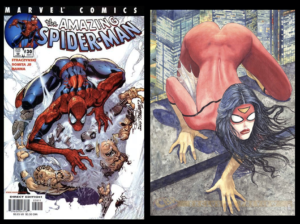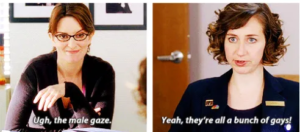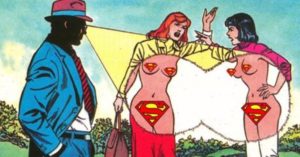From Katya:
This week we’re revisiting the Male Gaze. I know we’ve been here before but we have a string of guests coming up offering their own spin on various “gazes” and related subjects so we thought it was worth a revisit. (If you’d like to check out our previous conversations, check out some of our other topics here!)
I’ve run into a number of folks recently that think that in this age of increasing representation, the male gaze is a non-issue (and, sometimes, the idea that a gaze of any kind is not in play.) The premise seems to be that because we have greater diversity of characters along racial, cultural, gender, and sexuality lines than the issue disappears. Somehow?
But the male gaze explains precisely why all representation isn’t created equally. In its most basic form, the “gaze” describes the perspective that frames how people and things are presented in a piece of media. This includes the perspective of the creator(s), characters, and of the spectator themselves. The male gaze was coined by Laura Mulvey to describe how, in film, the male gaze shapes how women are presented. Basically, women are presented in ways that appeal to male creator, other male characters, and the (presumed to be) male audience rather than to appeal to women or be realistic. The male gaze is an expression of social power that distorts representation. Because the straight (also white) male is the most empowered subject it gets to determine what and who makes it in to media – and how it’s portrayed.
That’s a simplified version, anyway, the point is that it’s a critique of representation itself. If the representation carries forward a power imbalance (here, it’s gender but it could be race, nationality, sexuality etc.) then it’s… not necessarily better. Racial stereotypes are a clear example of this. Including a “diverse” cast that are pigeonholed into stereotypes is representation but it’s far from position because the characters are created to conform to a gaze defined by white supremacy.
I think, as a society, we seem to have gotten better at seeing this phenomenon at least in these very general terms. Where I think it gets challenging is when you apply the common surface-level version of this theory to more nuanced examples. Lara Croft from the Tomb Raider game franchise is an excellent example of this complexity. Her creators admit that she was designed with the male audience in mind and she fits the model of the standard large breasted-scantily dressed female avatar. She’s received mixed reviews from feminist critics and female gamers over time but there’s no denying her popularity among female gamers. Croft was most of our first chances to play a game with a female main character as a default, let alone one of the most iconic of her era. Rather than being the damsel-in-distress typically associated with the male gaze, she’s a powerful badass with agency and her sex appeal is part of that image. While the male gaze is certainly at play, she doesn’t fit the conventional power dynamic of the male gaze (although we need to talk about how having men and women play as her in the games enters this dynamic.)
We know the term “male gaze” gets thrown around a lot, and Mulvey’s article is less than accessible So, on this primer episode, what do YOU want us to explain about it?

From Mav:
So personally, I’ve been looking forward to this episode for a while. The male gaze is one of the most fundamental concepts I teach when I put together gender studies media classes. So yeah, like Katya said we could do this for weeks (and we are going to be doing it for at least a couple). We’re absolutely going to cover the basics of the theory, so industrious listeners who want to read up first should definitely check out Mulvey’s original essay. Yep, that’s right, homework for a podcast! But really I only say that because, like Katya said, Mulvey’s article is super confusing. And I often hear the term male gaze applied (and misapplied) in a billion different ways. For one thing she uses a bunch of Freudian psychoanalytic $5 school words even when she doesn’t have to, but also the concept is complex to start with. But also, people want to simplify it frequently to “sexy bad. not sexy good” and it’s way more complex than that. This comes up a lot with superhero comics because of the nature of the artwork, you’ll have some enterprising young incel try to say something like “no, this picture of Spider-woman isn’t sexist. Spider-man poses just like this all of the time” and then some enterprising young SJW will tell the incel “no that’s different because uh…” and the incel says “why?!?!” and the SJW is basically stuck with “uh…. because reasons.” Well, this is the show where we discuss “what are those reasons” and “why are they so complex?”
Katya’s Tomb Raider is a great example here and we’ll probably come back to it a bunch during the episode. Pretty much every time a new game or film entry has come out for the last couple decades there’s a bajillion think pieces in both popular press and academia that are basically “is this sexist or is it empowering” and the truth is that it’s not necessarily a binary answer. Again, the male gaze is sort of “how and why one doesn’t necessarily preclude the other.” Something can be empowering and problematic at the same time. We can have complex feelings about media because media will always be complex. So, as Katya said, we really want to hear some questions on this one. What are your thoughts on how the male gaze works? Are there things you think we should talk about? Do you have examples that you think can be confusing, complicated or just interesting? Let us know.









This is a great old chestnut of a question in game studies and media studies! Croft’s development, from an improbably triangle-boobed silent heroine to PTSD-stricken tough survivor is one of the most widely recognized and written-on IP developments in gaming, though in my view Croft’s gender cannot funtion in the game without attendant gazes of imperialism and whiteness. While lots of female gamers enjoy the rare opportunity to play as a strong, competant woman who, iun the last three games, at least, is normally proportioned if still improbably beautiful, what Croft DOES is deeply problematic. She is a potential feminist icon while simultaneously being a definite white supremacist one. The Sqare Enix reboot was well designed, fun to play, and adultified with gritty violence and trauma to match an aging target demorgraphic while still being able to bring in new players, but the core of the games still revolve around an extremely white womn showing up in a location with non-white indigenous people, then killing and blasting her way through anciet vistas, decimatuing the population or occasionally restructuring their political order (which is framed to be a moral action), all while casually looting artifacts for what is implied to be a personal collection.
The really intersting thing that I think specifically IS gendered about the newer Tomb Raider games, though, is the treatment of trauma and PTSD. We all know that AAA games like to flirt with these ideas without directly engaging with them in any complex way because 1. a PTSD simulator wouldnt be fun, and 2. PTSD is a politically charged topic when presented int he cotext of war, and games need to stay neutral to reach the widest possible player base, However, Croft’s horrible experiences and subsequent PTSD are on fuller display than just about any mainstream male character’s, and I think this is largely due to her gender. By using a female character, the devs broadly articulate rauma in ways that might be considered too feminine in a male figure. Comparing the semiotics of trauima between Croft and teh typically tragedy-haunted male comic book hero might be a fun project! I supsect that emotional loss is subject to gaze as much as bodies.
These are some really good points. The fact that Croft enacts an empire grounded in whiteness comes largely from genre norms. Although they ultimate meaning shifts because she’s a white woman, it’s an inherent problem of most war games (particularly from western dev companies, some of which have ties to DoD simulations etc. as well as military consulting that makes things… interesting) I’d be curious to know if players could be more conscious of these themes because we don’t associate violence/empire/etc. with women in the same way as conventional male heroes.
The idea that Croft is given wider expression of her emotions than conventional male heroes is a compelling one (I’m thinking of something like Solid Snake’s grin-and-bare-it silent attitude or Geralt from Witcher). It also intersects with historical stereotypes of female hysteria though, like the idea that women are overly emotional and prone to insanity while men just “push through.” So its both potentially positive in the sense that we see a story that at least begins to address these issues while simultaneously reinforcing the idea that women are weaker and/or irrational and that men aren’t emotional.